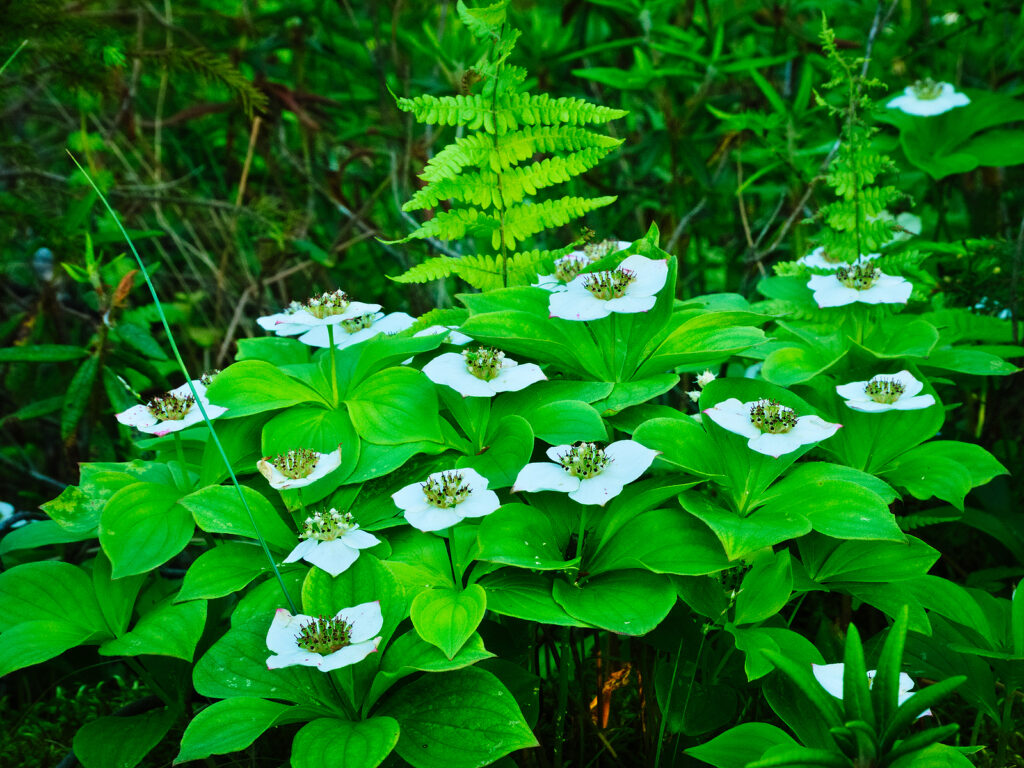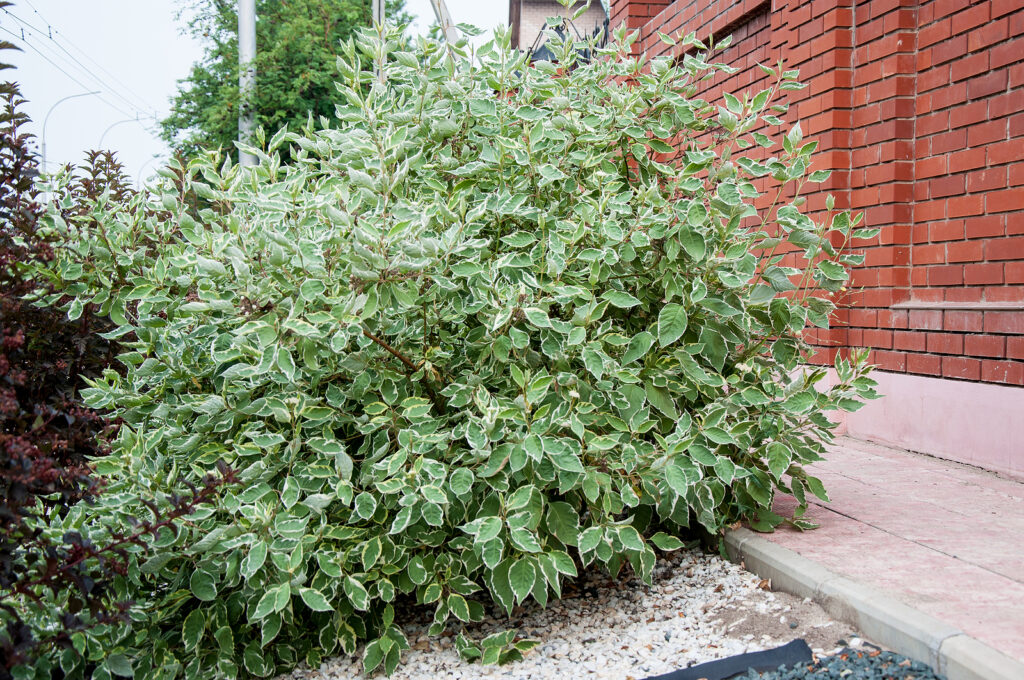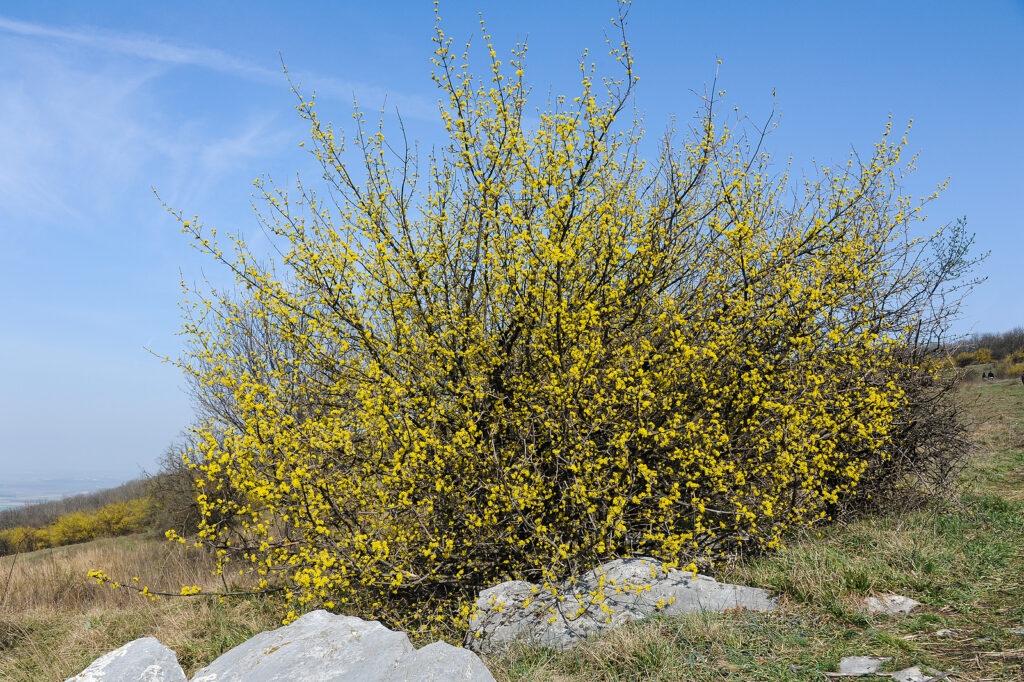Dogwoods, Cornus, are small to medium-size trees and shrubs. Many consider the dogwood the most beautiful of flowering trees. White and pink flowers appear in spring and remain on the tree for nearly a month, longer than other flowering trees.
Dogwoods are among the most useful of hardy ornamental woody plants. Some grow to fair-sized trees but most of them are free-growing shrubs.
Flowering Dogwood, Cornus florida, is one of the most beautiful features o the early spring landscape in the Atlantic Coast States and a favorite for garden planting wherever it will grow.
Dogwoods are adapted for many garden purposes and grow well in ordinary soil. For shady places, few shrubs are better but the variegated leaved forms are brighter in the open. The forms with colored stems are very effective in winter and grow and show to good advantage when grouped.
Fresh seeds sown in the fall in a cold frame usually germinate the following spring. Cornus alba and other kinds with rather softwood can be easily propagated from cuttings of mature shoots or by layering.
There are 45 species of dogwood from Asia and North America.

Get to know Cornus – Dogwood
- Plant type: Deciduous flowering trees and shrubs
- Growing Zones and range: 3-9 depending on the variety
- Hardiness: Cold hardy
- Height and spread: Size varies by variety—see descriptions below
- Foliage: Pointed leaves to 5 inches long with veins that curve out to the edge from its midrib; blazing red foliage in autumn
- Flowers: Small four-petaled, star-shaped white and pink flowers 3 to 5 inches wide; “flowers” are actually pointed bracts the true flowers are green and inconspicuous
- Bloom time: Spring
- Uses: Specimen tree, seasonal accents, natural areas, woodlands; grow for spring blooms and winter stem color
- Common name: Dogwood
- Botanical name: Cornus spp.
- Family: Cornaceae
- Origin: Northern temperate regions

Where to plant Cornus – Dogwood
- Grow dogwoods in full sun to partial shade.
- Plant dogwoods in humus-rich, moisture-retentive, well-drained soil.
- Dogwoods will tolerate waterlogged soil.
When to plant Cornus – Dogwood
- Young plants transplant beds during early spring.
Planting and spacing Cornus – Dogwood
- Space dogwood so they can grow to full maturity.

How to water and feed Cornus – Dogwood
- Grow dogwoods in just moist soil. Drought can cause trees to have pest and disease problems.
- Fertilize dogwoods with aged compost spread around the tree to the dripline at least once a year.
Cornus – Dogwood care and pruning
- Prune dogwoods to shape.
- Remove the oldest stems annually; the best color occurs on new growth.
- Shrubs grown for winter stem color need to be pruned back to early ground level every 2 to 3 years in late spring before the leaves appear.
Cornus – Dogwood common problems
- Stressed trees can have pest and disease problems. Keep the soil just moist.
- Anthracnose is a problem for Cornus florida; other dogwoods are immune to the disease.

Cornus – Dogwood propagation
- Propagation mainly from hardwood cutting taken in winter when stem color is most evident.
- Take cuttings in late winter or early spring. Cuttings will need to overwinter to gain strength and stature.
- Remove seed from its fleshy covering and sow in fall.
- Graft in late winter and early spring.

Cornus – Dogwood varieties to grow
- Cornus alba, red-barked or Tartarian dogwood: Multi-stemmed, vase-shaped to 10 feet tall; bears small white flower in spring, vivid red bark in winter; ‘Sidebar’ is a smaller cultivar with brilliant coral-red bark.
- Cornus alternifolia, Pagoda dogwood: Zones 3-7; to 20 feet tall and 12 feet wide; flat-topped with horizontal branches; small white or yellow flowers in flat clusters in late winter to early spring followed by black fruit.
- Cornua canadensis, bunchberry: Deciduous shrub to 9 inches high; creeping rootstocks, green leaves turn yellow in fall; bears tiny white flowers in clusters.
- Cornus controversa, giant dogwood: Grows to 40 feet tall; difficult to find.
- Cornus capitata, evergreen dogwood: yellow-flowered, glossy green leaves to 40 feet tall.
- Cornus florida, flowering dogwood, eastern dogwood: Zones 5-9; 20 to 25 feet tall and wide; slow grower; drifts of white flowers in spring before leaves; horizontal tiered; turn red to purple in autumn; ‘Cherokee Chief’ has dark pink flowers; ‘Plena’ has double white flowers; ‘Variegata’ has white and green leaves.
- Cornus kousa var. chinensis, Kousa dogwood: Zones 5-8; 20 to 30 feet tall and wide; picturesque with horizontal layers of leaves in place before white flowers appear; fruit resembles small strawberry, fall foliage in shades of red and purple; peeling, multicolored bark exfoliates and provides winter interest; specimen or seasonal accent.
- Cornus mas, Cornelian cherry dogwood: Zones 4-8; 10 to 20 feet tall and 10 to 15 feet wide; golden blooms in spring; edible cherry fruit in summer; use as a specimen or in shrub borders and hedges; ‘Aureo-elegantissima’ has yellow blossoms brushed with pink; ‘Variegata’ has cream-colored leaf margins.
- Cornus nuttallii, Pacific or mountain dogwood: native from British Columbia to southern California, grows to 75 feet; showy white bracts.
- Cornus racemosa, gray dogwood: Zones 4-7; 10 to 15 feet tall and wide; umbels of white spring flowers turn into white berry-like fruits; older wood develops gray bark, younger wood is pink.
- Cornus sanguinea, bloodtwig dogwood: Shrub with dark red foliage; bare purplish to dark red twigs and branches; grows to 12 feet high and 8 feet wide; greenish-white flowers in spring.
- Cornus sericea, formerly stolonifera, redtwig dogwood: Zones 2-8; 8 to 10 feet tall, 5 to 10 feet wide; rapid growth; greenish stems turn bright red in winter; twig color intensifies with sun exposure; use in shrub borders and along fences; ‘Flagstoned’ has golden twigs.
- Cornus stolonifera ‘Flavieramea’, yellow-twig dogwood: Zones 3-8; 6 to 8 feet tall, 8 to 10 feet wide; yellow stems brighten winter; color can be overwhelming; use in a shrub border, along fences and drives; ‘Isanti’ has bright red stems.
Cornus – Dogwood frequently asked questions
Q: Which dogwood shrubs have colored twigs in winter?
A: Tartarian dogwood (Cornus alba) has bright red twigs. Red Osier dogwood (Cornus stlonifera) has deep red twigs. Goldentwig dogwood (Cornus stolonifera flaviramea) has yellow twigs. Bloodtwig dogwood (Cornus sanguinea) had dark blood-red twigs. Greentwig dogwood (Cornus sanguinea viridissima) has green twigs.
Q: How can I use shrubby dogwoods in my landscape?
A: Shrubby dogwoods can be planted in mass to create a woodland border. They can be planted as an informal hedgerow or they can be added to a mixed shrub planting.
Q: I planted a Cornelian cherry (Cornus mas) three years ago and it has not grown. Why?
A: Dogwoods can take a few years to become established. If you suspect there is a soil problem, add aged compost to the planting bed a couple of times a year; in time, the soil will improve. You can also fertilize dogwoods with a balanced fertilizer such as 5-10-10.















